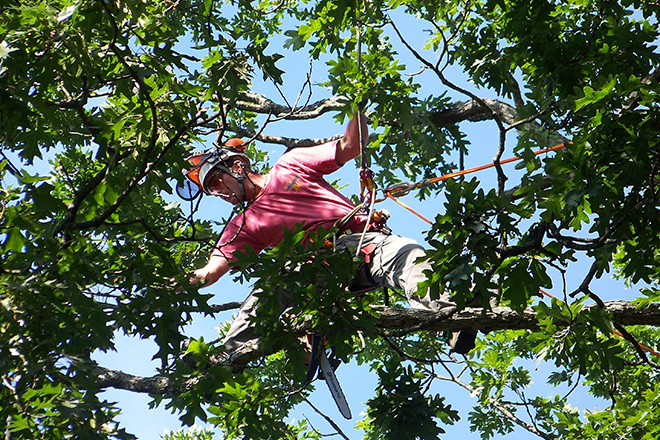It wasn’t New England’s first harsh winter and it won’t be its last. Area professionals weigh in on how to evaluate the condition of your trees and plants and offer new suggestions to spruce up your container gardens, window boxes and surrounding landscape in the months ahead.
The good news: New England survived the snowiest five-week stretch on record. The bad news: the unenviable milestone wasn’t reached without repercussions. But if you’re looking out on your lawn or patio and wondering if your trees, plants and containers will ever be lush again, there’s hope.
“I’m sure people lost a lot of stuff,” says horticulturist Patrick Shellman of the Fantastic Umbrella Factory Gardens in Charlestown. “A lot of things aren’t even up yet and should be.” Fortunately for Patrick, the bulk of his concentration is on container plants – many tropical varieties plus perennials like ferns and bromeliads, grown in cozy greenhouses. Though Patrick’s plants are as colorful as they are plentiful, they are also tailored to the less-than-stellar green thumbs.
“I’ve weeded out all the hard stuff,” says Patrick with a laugh. “Everything I grow is easy to maintain.” Patrick says he’s been gardening and growing since childhood, and has been at the lauded Umbrella Factory Gardens for 36 years, arriving not long after Robert Bankel established the Umbrella Factory on his own farmland.
Today, head-turning decorative plants, like the banana plant with its signature large palm leaves are just one of Patrick’s suggestions for trees that are both striking and versatile. Banana plants are a prime example of a plant that does well outside in the summer months and if positioned in a sunny spot in the winter, can survive and thrive. “I sell a lot of them every year. I grow a red leaf one that grows so big,” he says. Another one of Patrick’s favorites is the papyrus plant, a tall aquatic plant with a distinctive, whimsical look. “They have a big pom pom head on them and they’re great,” he says. Both of these do require frequent watering, but not much more.
To inspire visitors to create inspiring, colorful containers in and around their homes and yards, Patrick crafts oversized display arrangements in containers and hanging baskets, and he’s always willing to dole out advice. “I put on a big display; big containers and huge hanging baskets just for people to look at and try to do,” he says. But not everyone is as confident in their own gardening skills, so one day, a customer brought Patrick a container and wanted the skilled horticulturist to work his magic in the provided pot. Soon, “bring-your-own-containers” became common practice at the Umbrella Factory Gardens. “People bring me hundreds and hundreds of containers and I make up things that work well together depending on the sun they get,” he says. Patrick’s also keenly aware of how big each plant will grow, how much space it will need in the container to thrive, and what invasive plants to avoid. “I like coleus but when you try to put them in a nice container... they tend to take over. I recommend they go in a pot by themselves,” he explains. Though customers are welcome to bring their own containers, most are equally enchanted with the containers the Fantastic Umbrella Factory Gardens has on site for sale. Patrick says they sell about 6.5 tons of pottery there annually. 420 Old Post Road, Charlestown. 401-364-6616, fantasticumbrellafactory.com
While plants have a lot of do-it-yourself options, trees are a different story. “Someone inexperienced in the field of arboriculture can do a great deal of damage, often irreversible, to a valuable tree or plant in a very short period of time,” explains Tom Morra of T.F. Morra Tree Care. “Anything that involves working off of the ground should be left to a trained professional arborist.” Morra’s company holds an International Society of Arboriculture (ISA) Certification and has been declared a Certified Treecare Safety Professional (CTSP) by the Tree Care Industry Association. Though voluntary, these credentials show consumers an arborist’s level of professionalism and commitment to the craft.

Tom says now is the time to take a look at your trees and see how they managed our coldest season. “Mature deciduous trees fared pretty well... Evergreen trees, however, suffered significant winter injury from severe and extended cold periods, and smaller, delicate plants definitely took a beating from all of the snow,” he explains. Signs of winter injury include yellowing or browning foliage, sometimes resulting in dieback. For smaller plants, he says, inspect trunks and branches for cracking or bent/broken stems. Sometimes bent or broken branches can be cabled or otherwise anchored back in place, but more often they need to be pruned out. “As far as winter injury, a good dose of foliar fertilizer can really help green them back up in the spring. I also recommend starting a spray program with antitranspirant in the fall,” he says, so you can give a layer of protection going into the colder months.
If you’re looking to add more trees to your landscape, Tom suggests sticking with native species as well as trees that are locally grown since they are intrinsically adapted to our climate. “It’s always a good idea to consult with a knowledgeable arborist about species selection for a particular situation and to make a good selection for the long term health of the tree as well as the rest of your landscape,” he adds. “When managed properly, the trees and plants in your landscape can contribute significantly to property value while providing shade, beauty and all of nature’s benefits at the same time.” 401-331-8527, tfmorra.com
Comments
No comments on this item Please log in to comment by clicking here